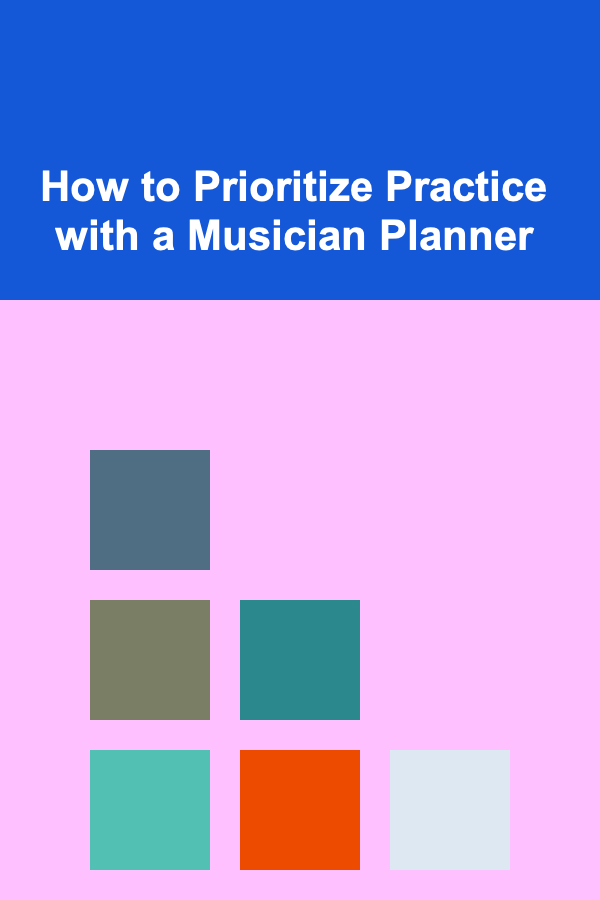
How to Prioritize Practice with a Musician Planner
ebook include PDF & Audio bundle (Micro Guide)
$12.99$8.99
Limited Time Offer! Order within the next:

Musicians, whether amateur or professional, are constantly refining their craft, striving for perfection, and facing the challenges of time management. Among these challenges, perhaps the most universal is how to structure practice effectively. Practice, when done mindfully and systematically, is the key to improving musical skills. However, even the most dedicated musicians may find themselves overwhelmed with the volume of tasks at hand---be it learning new pieces, improving technique, preparing for performances, or maintaining routine exercises. A Musician Planner is a powerful tool to help musicians organize their practice sessions, set priorities, track progress, and make the most of their valuable practice time.
Creating a strategy for how to prioritize practice with a musician planner is not only essential for improving skills but also for sustaining motivation and avoiding burnout. In this article, we will explore how musicians can use planners to structure their practice, maximize efficiency, and stay on track with long-term musical goals.
1. The Role of a Musician Planner in Time Management
One of the most common issues musicians face is time management. With many demands on their time---whether school, work, or family obligations---it can be challenging to maintain a consistent practice schedule. Without a structured plan, practice sessions often become inconsistent, disorganized, or counterproductive.
A musician planner can help address these challenges by:
- Scheduling Practice Sessions: By setting specific practice times, musicians can ensure that they dedicate time each day to work on their instrument.
- Breaking Down Goals: A planner allows musicians to break down long-term goals (such as learning an entire symphony) into smaller, manageable tasks.
- Tracking Progress: By tracking daily progress and documenting improvements, musicians can see tangible results and stay motivated.
- Avoiding Overwhelm: A planner helps musicians prioritize tasks, ensuring that they focus on the most important areas of improvement, rather than trying to do everything at once.
Overall, a musician planner acts as a tool for increasing productivity and helping musicians maintain focus, ensuring that their efforts are channeled toward meaningful progress.
2. Assessing Your Musical Goals
Before you can prioritize your practice, it's essential to have a clear understanding of your musical goals. These goals may vary greatly depending on your level of expertise, the instrument you play, or the kind of music you wish to pursue. Here are some examples of typical goals:
- Short-term Goals :
- Learn a specific piece or song.
- Improve technical proficiency in a particular area (e.g., scales, arpeggios).
- Prepare for an upcoming performance or audition.
- Master a particular musical technique or concept (e.g., vibrato, articulation).
- Long-term Goals :
- Become proficient on your instrument.
- Achieve a specific level of playing (e.g., master intermediate, advanced repertoire).
- Build a personal musical style or voice.
- Pursue professional performances or recordings.
Having both short-term and long-term goals helps musicians stay focused. These goals will also serve as the foundation for prioritizing practice sessions.
3. Structuring Your Practice Time
The key to successful practice lies in structuring each session in a way that supports your goals and avoids fatigue. The Pomodoro Technique, often used in productivity settings, can be adapted for musical practice. This technique involves breaking practice into intervals of focused work, typically 25 minutes of practice followed by a 5-minute break.
Key Elements to Structure Your Practice:
- Warm-up (5-10 minutes): Start with scales, technical exercises, or finger stretches to get the body and mind prepared for focused work.
- Focused Practice (20-30 minutes): This is the meat of your session where you tackle the specific areas you want to improve. This may include learning new sections of a piece, working on difficult passages, or focusing on musical technique.
- Break (5-10 minutes): Take a short break to rest your fingers and mind. This helps maintain focus during your practice.
- Review (10 minutes): At the end of each session, briefly review the material you practiced. This ensures that you are consolidating your learning and allows you to identify areas that need more attention in future sessions.
- Cool Down (5-10 minutes): Play something you enjoy or something that feels easy. This is a time to relax and leave practice on a positive note.
The musician planner should include blocks of time for each section of practice. By breaking down the session into focused intervals, you ensure that each area of your musicianship is addressed without feeling rushed or fatigued.
4. Prioritizing Areas of Focus
There are many aspects to practice that can compete for your attention---new pieces, technical skills, ear training, sight-reading, and improvisation. With so much to focus on, how do you decide what to prioritize?
Focus on Weaknesses:
When structuring your practice, it's essential to identify areas that require the most attention. If you're struggling with a particular aspect of playing---such as sight-reading or playing in a difficult key---those areas should take precedence. In a musician planner, these can be highlighted to ensure that you're addressing your weaknesses while balancing other aspects of your playing.
Rotate Focus Areas:
While it's important to prioritize areas of weakness, it's equally important to give time to other areas as well. A well-rounded practice routine should include:
- Technique: Exercises that build fundamental skills and motor coordination.
- Repertoire: Learning new pieces and polishing old ones.
- Ear Training: Developing the ability to recognize intervals, chords, and melodies by ear.
- Sight-reading: Improving your ability to read and play new music fluently.
By rotating between these focus areas each week, you can ensure that you're making progress across all dimensions of musicianship. A musician planner is ideal for managing this rotation, allowing you to plan your week to balance between technical exercises and repertoire practice.
Break Long-Term Goals into Smaller Steps:
If your long-term goal is to learn an entire piece or become proficient in a complex musical technique, break this goal into smaller, more manageable steps. For example, if you want to master a sonata, break it down into:
- Mastering the first movement.
- Perfecting the transitions between sections.
- Focusing on dynamics and articulation.
This incremental approach helps you stay motivated and see continuous progress. Use your planner to track each of these steps, setting deadlines and reviewing progress regularly.
5. Consistency Over Perfection
One of the most important lessons for any musician is that consistency is far more effective than striving for perfection in every practice session. Rather than focusing on playing perfectly every time, aim for steady, consistent improvement.
A musician planner helps enforce this approach by encouraging daily practice and small, achievable goals. For instance, instead of trying to perfect an entire piece in one practice session, focus on perfecting a small section of the music. By tracking these smaller victories, you build momentum that leads to greater long-term progress.
6. Tracking Progress and Adjusting Your Plan
Your musician planner should not only be a tool for scheduling and organizing your practice but also a tool for tracking progress. Keeping a record of what you've accomplished can be incredibly motivating, as it allows you to see how much you've improved over time.
Some key items to track include:
- Pieces Learned: Record each piece or section of music you've learned and when you've learned it.
- Technical Improvements: Note any technique-related breakthroughs or challenges (e.g., finger independence, tone production).
- Performance Readiness: Track whether you're ready for upcoming performances or auditions, noting areas that need more work.
At the end of each week or month, review your progress and adjust your plan as necessary. If you find certain areas are lagging behind, spend more time on them. If you've mastered a section quicker than expected, move on to the next challenge.
7. Avoiding Burnout
One of the greatest challenges musicians face is burnout---the feeling of exhaustion or lack of motivation that can stem from over-practicing or practicing inefficiently. A musician planner helps prevent burnout by ensuring that your practice schedule is balanced, with sufficient time for rest and recovery.
- Take Breaks: Don't skip breaks during your practice sessions. Regular short breaks help to keep your mind sharp and your body relaxed.
- Rest Days : It's equally important to schedule rest days. Even professional musicians need time off from their instruments to avoid overuse injuries and mental fatigue.
Balancing intense practice with adequate rest is crucial for maintaining long-term enthusiasm and progress.
8. Motivating Yourself
A musician planner serves as a tool for motivation. By setting clear goals, tracking your progress, and celebrating small achievements, you stay inspired to keep practicing. Additionally, planners can be filled with inspirational quotes, reminders of your long-term vision, and personal notes that keep you connected to your musical passion.
Celebrating your success, whether big or small, helps to build confidence and maintain a positive relationship with your instrument.
Conclusion
Prioritizing practice with a musician planner is a powerful way to stay organized, manage your time, and ensure steady progress in your musical journey. By setting clear goals, structuring practice sessions efficiently, and tracking progress, you can transform your practice routine into a well-oiled machine. The key is consistency, balance, and the understanding that progress takes time. With the right tools and mindset, your musical aspirations can become a reality. A musician planner is more than just a schedule---it's a reflection of your commitment to growth and mastery.
Reading More From Our Other Websites
- [Home Maintenance 101] How to Maintain a Historic Home: Preserving Its Charm
- [Home Soundproofing 101] How to Soundproof a Music Studio at Home for Professional-Grade Sound Isolation
- [Organization Tip 101] What Are the Most Efficient Ways to Organize Your Shopping List?
- [Home Party Planning 101] How to Document Your Party for Social Media Sharing
- [Home Cleaning 101] How to Tackle Pet Hair Everywhere in Your Home
- [Home Renovating 101] How to Renovate Your Home on a Tight Budget and Still Get Great Results
- [Organization Tip 101] How to Create a Personalized Study Environment
- [Organization Tip 101] How to Use Pinterest for Recipe Organization and Inspiration
- [Personal Care Tips 101] How to Create a Long-Lasting Glossy Lip Look with Lip Gloss
- [Organization Tip 101] How to Teach Kids About Pantry Organization

How to Create a Financial Plan After Divorce
Read More
How to Create a Vision Board for Academic Goals and Supplies
Read More
How to Leverage YouTube's Super Chats and Channel Memberships for Extra Income
Read More
How to Monetize Your Craft Hobbies on Etsy and Beyond
Read More
How to Plan a Budget for Staging Cost Per Room Without Overspending
Read More
10 Tips for Writing a Compelling Political Science Paper
Read MoreOther Products

How to Create a Financial Plan After Divorce
Read More
How to Create a Vision Board for Academic Goals and Supplies
Read More
How to Leverage YouTube's Super Chats and Channel Memberships for Extra Income
Read More
How to Monetize Your Craft Hobbies on Etsy and Beyond
Read More
How to Plan a Budget for Staging Cost Per Room Without Overspending
Read More